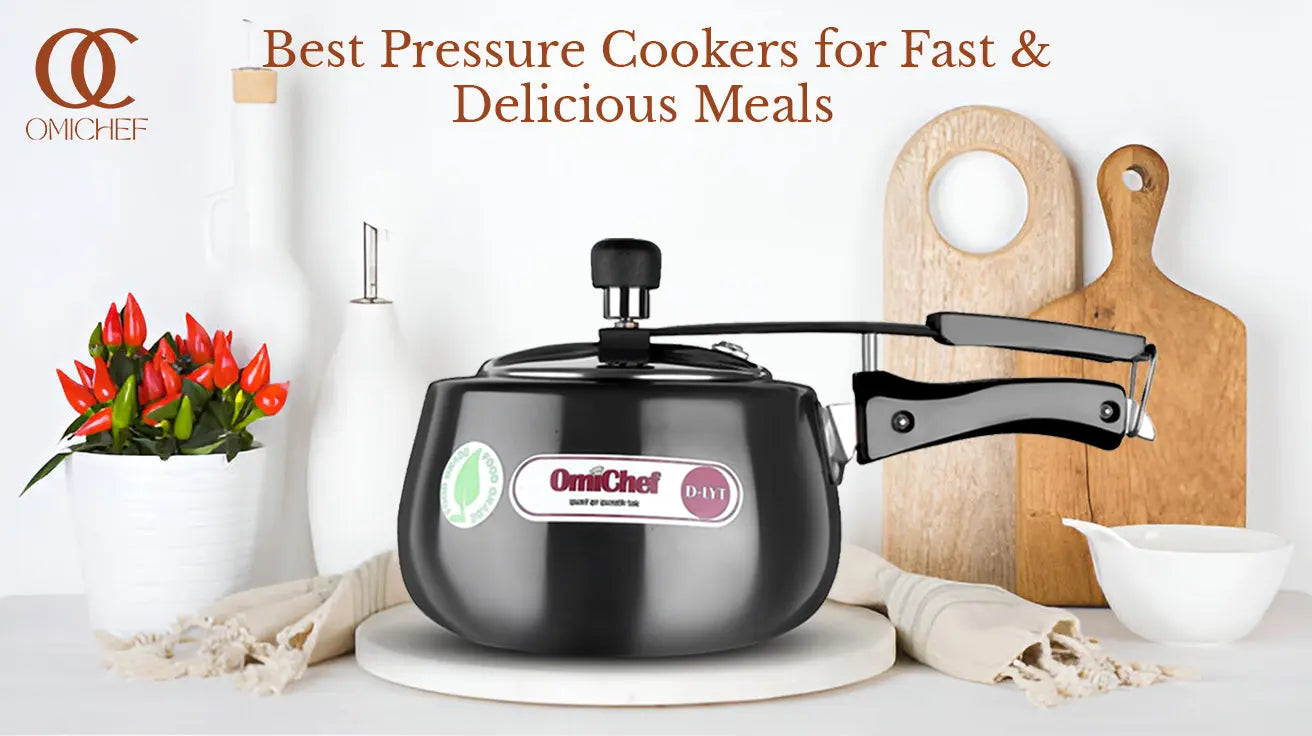Introduction to Pressure Cooker
A Best pressure cooker is a kitchen appliance that uses steam and pressure to cook food quickly, locking in moisture, flavors, and nutrients. It works by sealing the food inside a tightly closed container, where steam builds up as the liquid inside heats. This increases the pressure within the cooker, which raises the boiling point of water, allowing the food to cook at higher temperatures than normal, significantly reducing cooking time. There are two main types of pressure cookers: stovetop and electric.
- Stovetop pressure cookers are traditional models that rely on direct heat from your stove. They tend to cook faster because they can reach higher pressure, but require more attention since you need to monitor the heat level and timing manually.
- Electric pressure cookers, like the popular Instant Pot, are more user-friendly and come with pre-programmed settings for different foods. They have built-in temperature and pressure control, allowing for a more hands-off cooking experience. Electric models also often include additional functions such as slow cooking, sautéing, and even yogurt-making, making them a versatile option for home cooks.
Both types offer significant time savings, but the electric version provides a more hands-off approach, making it a favorite for many modern kitchens.
Best Pressure Cookers for indian Kitchen.
Time-Saving Benefits
One of the primary reasons pressure cookers have become a must-have in modern kitchens is their ability to drastically reduce cooking time. Whether you're preparing a hearty stew, cooking grains, or braising meat, the best pressure cooker can cut cooking times by up to 70% compared to traditional methods. This is especially beneficial for busy individuals or families who want to prepare healthy, homemade meals without spending hours in the kitchen.
For instance, dishes that typically take hours, such as pot roast or risotto, can be done in under 30 minutes with a pressure cooker. The high-pressure environment speeds up the cooking process by forcing moisture and heat into the food, helping it cook faster without sacrificing flavor. This time-saving benefit makes pressure cookers a game-changer for anyone with a hectic schedule but still wants the satisfaction of a freshly prepared meal.
Flavor Enhancement
Pressure cooking is renowned for its ability to enhance the natural flavors of food, making dishes more delicious and aromatic. The best pressure cooker creates a sealed environment where steam and heat circulate, locking in the flavors and moisture that would otherwise escape during traditional cooking. This means that ingredients like meats, vegetables, and herbs release their full taste potential, intensifying the overall flavor profile of your meal.
The pressure also ensures that seasonings and spices are absorbed more deeply into the food, creating rich, robust flavors. Additionally, since pressure cooking requires less water than other methods, fewer nutrients are lost in the cooking process, allowing your meals to retain more of their natural vitamins and minerals. This results in meals that are not only more flavorful but also more nutritious, making pressure cooking an ideal choice for health-conscious individuals who don’t want to sacrifice taste.

Top Recipes for Beginners
If you're new to pressure cooking, starting with a few simple, beginner-friendly recipes can help you get comfortable with this powerful kitchen tool. Here are some easy recipes to get you started:
- Rice Dishes – Whether you are making plain white rice, fluffy jasmine rice, or a savory pilaf, a pressure cooker ensures perfectly cooked rice every time. It's much faster than using a stovetop or rice cooker and requires minimal attention.
- Chili – A perfect dish to experiment with in your pressure cooker. Throw in ground meat, beans, tomatoes, and spices for a rich, flavorful chili that’s ready in under an hour.
- Pasta with Sauce – You can even cook pasta in your pressure cooker! Simply combine pasta, sauce, and broth, and you’ll have a full meal with minimal effort.
These recipes are not only quick and easy but also showcase the versatility of the best pressure cooker, giving you a chance to explore different types of meals with ease.
Tips for Getting the Most Out of Your Best Pressure Cooker
To make the most of your pressure cooker, here are a few essential tips that can enhance your cooking experience and results:
- Check the Seal: Before each use, ensure that the rubber or silicone sealing ring is properly positioned and free of cracks or food particles. A well-sealed lid is crucial for maintaining the pressure needed for efficient cooking.
- Add Enough Liquid: Pressure cookers need liquid to create steam, which generates the pressure for cooking. As a rule of thumb, add at least one cup of liquid (water, broth, or sauce) to prevent food from burning and to build pressure effectively.
- Adjust Cooking Times by Ingredient: Softer vegetables like zucchini cook much faster than tougher ingredients like meat or potatoes. If you’re cooking a dish with mixed ingredients, consider adding softer ingredients later, or cutting denser ingredients into smaller pieces to help them cook evenly.
- Don’t Overfill: To avoid issues with pressure buildup, only fill your pressure cooker up to the halfway mark when cooking ingredients that expand (like grains or beans) or up to two-thirds full for other foods. This prevents clogging of the pressure release valve and ensures the food cooks evenly.
- Use Natural Pressure Release for Delicate Foods: For ingredients that can easily become overcooked, such as vegetables or pasta, use the "natural release" method, which allows pressure to drop gradually. This prevents rapid steam release, which can sometimes cause foods to break apart or lose texture.
- Brown Your Ingredients First: If your recipe calls for meat, onions, or spices, consider browning them in the pot before sealing the lid. Many electric pressure cookers have a sauté function that allows you to do this without switching pans. Browning enhances flavor and brings a richer taste to your dishes.
By following these tips, you can maximize the flavor, texture, and overall results of your dishes, truly making the most out of the best pressure cooker in your kitchen.

Pressure Cooker Myths
Despite their popularity, there are still many misconceptions surrounding pressure cookers. Here are a few common myths—and the truth behind them:
-
Myth: Pressure Cookers Are Dangerous
Truth: Modern pressure cookers are designed with numerous safety features, including locking lids, pressure release valves, and automatic shut-offs. These advancements make them much safer than the pressure cookers of decades past. When used properly and maintained well, a pressure cooker is a safe, reliable kitchen tool. -
Myth: Pressure Cooking Reduces Nutritional Value
Truth: Pressure cooking actually retains more nutrients compared to boiling or steaming for long periods. The shorter cooking time and closed environment help preserve vitamins and minerals, making meals prepared in a pressure cooker highly nutritious. -
Myth: Pressure Cookers Can Only Be Used for Stews and Soups
Truth: Today’s best pressure cookers are incredibly versatile. They can cook everything from risotto to yogurt, steam vegetables, cook rice, braise meats, and even bake cakes. Electric models often come with multiple cooking functions, turning one appliance into a multi-functional kitchen helper. -
Myth: Pressure Cookers Are Only for Large Batches
Truth: While pressure cookers are great for meal prepping, you don’t have to make large portions. Many models come in various sizes, and you can easily adapt recipes to cook smaller servings if needed. -
Myth: Pressure Cookers Require Constant Monitoring
Truth: One of the biggest advantages of pressure cookers—especially electric models—is their hands-off nature. You simply set the time and let the cooker handle the rest. Most electric models automatically adjust to maintain the right pressure, making them ideal for busy cooks.
These myth-busting facts help highlight the practicality and versatility of the pressure cooker, making it clear why it’s become a trusted tool in kitchens around the world.
Health Benefits
One of the greatest advantages of cooking with a Best pressure cooker is its ability to retain more vitamins and minerals compared to other cooking methods. Because pressure cooking uses higher temperatures and shorter cooking times, nutrients in the food are preserved, rather than being broken down or lost through prolonged exposure to heat. Studies have shown that pressure-cooked vegetables retain more vitamins, like vitamin C, and minerals, making meals healthier overall.
Additionally, pressure cooking requires less added fat and oils than frying or sautéing, making it a heart-healthy option for those looking to cut back on fats. The best pressure cooker also allows you to cook beans, whole grains, and lean proteins easily, encouraging a diet rich in fiber and plant-based nutrients. By preserving flavors and nutrients, pressure cooking offers a convenient way to prepare balanced, healthful meals for any diet.
Pressure Cooker Alternatives
While pressure cookers offer convenience and efficiency, it's worth comparing them to other popular kitchen appliances to see which one best fits your cooking style and needs. Here’s a look at how pressure cookers stack up against slow cookers and air fryers:
-
Pressure Cooker vs. Slow Cooker
A slow cooker is ideal for “set-it-and-forget-it” cooking, where ingredients are added early in the day and cooked at a low temperature over several hours. This method is great for enhancing flavor in dishes like stews and roasts, but it requires more planning due to the longer cooking time. A pressure cooker, on the other hand, achieves tender and flavorful results in a fraction of the time, making it a better choice for those who need meals prepared quickly. -
Pressure Cooker vs. Air Fryer
An air fryer is specifically designed to crisp and brown foods with little to no oil, making it ideal for achieving a “fried” texture in a healthier way. However, air fryers are less versatile for dishes with liquid, such as soups or stews, where a pressure cooker excels. While both appliances can offer healthy meal options, the best pressure cooker allows for a broader range of recipes, from grains and beans to braised meats and vegetables. -
Multi-Cookers: The Best of Both Worlds
For those who want the benefits of both pressure and slow cooking, many electric pressure cookers now function as multi-cookers, with slow-cook and air-fry settings included. These versatile appliances give you the option to slow-cook, pressure-cook, or even air-fry in a single device, making them ideal for maximizing functionality in smaller kitchen spaces.
By understanding the strengths of each appliance, you can choose the best tool—or combination of tools—for your cooking needs. A pressure cooker’s speed and versatility make it a valuable addition to any kitchen, especially when paired with other appliances that complement its strengths.

Conclusion:
Best Pressure cookers have become an essential tool for modern kitchens, offering a unique combination of speed, flavor, and health benefits that few other appliances can match. They simplify meal preparation, allowing even the busiest individuals to enjoy home-cooked dishes in a fraction of the usual time. With the ability to retain nutrients and enhance flavors, the best pressure cooker provides both convenience and quality in every meal.
Whether you are new to pressure cooking or an experienced cook, understanding its many advantages—from its time-saving capabilities to its versatility across different types of dishes—can transform the way you approach cooking. With helpful tips, beginner-friendly recipes, and debunked myths, anyone can get comfortable using a pressure cooker to create delicious, nutritious meals. Ultimately, this reliable appliance isn’t just about faster cooking; it’s about unlocking a world of flavors, health benefits, and cooking possibilities in your kitchen.
We are available on flipkart and amazon, you can visit our e-commerce platform and our website. omichef.

